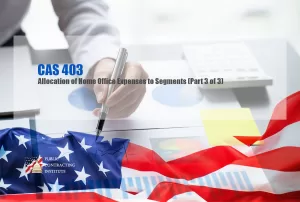*This is Part 3 of a 3-part blog. Each part addresses the fundamental requirements and techniques for application related to the standard, and provides specific examples.
- Part 1 addressed the basic requirements/techniques for allocating home office expenses to segments.
- Part 2 addressed the requirements/techniques for allocating home office residual expenses to segments.
- This Part 3 will addresses special allocations of home office expenses to segments.
Background: To provide criteria for allocating home office expenses to the segments of an organization based on the beneficial or causal relationships between the expenses and the receiving segments (CAS 403-20(a)).
Special Allocations of Home Office Expenses to Segments
- In accordance with CAS 403‑40(c)(3) and CAS 403-50(d), where a particular segment receives significantly more or less benefit from residual expenses than would result if the requirements of the standard were applied, a special allocation may be agreed to between the Government and the contractor
EXAMPLE: A contractor that is required to allocate home office expenses using the three-factor formula has five segments. Four of these segments provide services with very little tangible capital assets. The fifth segment, Segment P, is in the leasing businesses and owns a very large dollar amount of real and personal property. In fact, Segment P owns 98% of the total tangible capital assets of the contractor. Segment P has approximately the same number of employees as each of the other segments and generates approximately the same amount of revenue. In this case, the contractor and the Government may agree on a special allocation to Segment P.
- When a special allocation is used for a particular segment, CAS 403‑40(c)(3) requires that the amount of the special allocation be removed from the residual expense pool. In addition, the data for that particular segment must be removed from the base used to allocate the residual expenses
EXAMPLE: Assume that of the five contractor segments in the prior example, the contractor and the Government agree on a special allocation for Segment P, and that the amount of that special allocation should be one-fifth of the total residual expenses for the year. The total residual expenses for FY 2013 are $5,000,000. Segment P would therefore receive $1,000,000 in residual expenses for FY 2013. The remaining $4,000,000 ($5,000,000 less the $1,000,000) would be allocated to the other four segments. In computing how much of the $4,000,000 is allocated to the other four segments, Segment P’s data is excluded from the payroll, revenue, and net book value calculations, illustrated as follows:
Percentages without special allocation:
| Segment L | Segment M | Segment N | Segment O | Segment P | |
| % of segment payroll dollars | 25% | 22% | 21 | 13 | 20 |
| % of segment operating revenue | 24% | 17% | 29% | 11 | 19 |
| % of segment average net book value | 1% | 0 | 1 | 0% | 98 |
Percentages with special allocation:
| Segment L | Segment M | Segment N | Segment O | Segment P | |
| % of segment payroll dollars | 31% | 27 | 25 | 17 | EXCLUDED |
| % of segment operating revenue | 30% | 21 | 35 | 14 | EXCLUDED |
| % of segment average net book value | 32 | 21 | 30 | 17 | EXCLUDED |
| Average | 31 | 23 | 30 | 16 | EXCLUDED |
Using the special allocation, the residual expenses of $5,000,000 would be allocated to the five segments as follows:
| Segment | Average % (A) | Residual Expenses (A*$4,000,000) |
| L | 31 | $1,240,000 |
| M | 23 | $ 940,000 |
| N | 30 | $1,200,000 |
| O | 16 | $ 640,000 |
| P | N/A | $1,000,000 |
| Total | $5,000,000 |
- In some cases, home office functions are performed by an organization that is not part of the legal entity with which the Government has contracted. In such cases, CAS 403-50(e) states that the contracting corporation may accept allocations from this organization to the extent that such allocations meet the requirements set forth in CAS 403.
EXAMPLE: Contractor X has three subsidiaries, Subsidiary A, Subsidiary B, and Subsidiary C. The Government enters into contracts with Subsidiary A. While Contractor X is not part of the legal entity “Subsidiary A” with which the Government has contracted, Contractor X may still allocate the cost of home office functions to Subsidiary A, provided such allocations meet the requirements of CAS 403.


